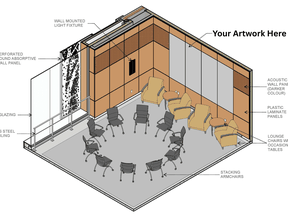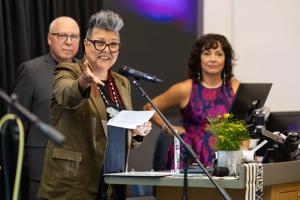Entertainment
Indigenous Artists Showcase Connection to Ocean in New Exhibit

The Vancouver Art Gallery has unveiled a powerful new exhibition titled We who have known tides, running from November 6, 2023 to April 12, 2024. Curated by Camille Georgeson-Usher, the showcase features the work of nine Indigenous artists, each of whom explores their profound relationship with the ocean. This exhibition aims to evoke deep emotional connections to the sea and its myriad beings.
At the heart of the exhibition is a looping two-minute video by Nicholas Galanin, a Lingít (Tlingit) and Unangax̂ artist. Titled k’idéin yéi jeené (You’re doing such a good job), the film portrays a tender interaction between Galanin and his young son on Lingít territory. As Galanin speaks soft affirmations in his native language, the boy’s expressions shift from curiosity to joy, inviting visitors to experience a moment of intimacy and warmth. “I hate to show bias, but it’s one of my favourite things I’ve seen in a long time,” remarked Georgeson-Usher, highlighting the emotional impact of the piece.
As guests progress through the exhibition, they encounter a dramatic centerpiece of undersea masks, a vital component in the emotional narrative Georgeson-Usher aims to create. The exhibition not only highlights the ocean’s physical presence but also its metaphorical significance, representing political, personal, and social tides.
Curatorial Vision and Cultural Connections
Georgeson-Usher, who has Indigenous roots from the Sḵwx̱wú7mesh (Squamish) and Dene nations, expressed her desire to ground the exhibition in her experiences. “I had too much to choose from,” she said, reflecting on the rich collection of Indigenous contemporary art. The ocean emerged as a grounding force, shaping the narrative of the exhibition and inviting audiences to feel its ebb and flow.
The exhibition marks Georgeson-Usher’s inaugural project as the gallery’s newly appointed Audain Senior Curatorial Advisor on Indigenous Art. Funded by the Audain Foundation, this is the first role of its kind at the gallery, located on the traditional territories of the xwməθkwəy’em (Musqueam), Skwxwú7mesh, and səlilwətaɬ (Tsleil-Waututh) peoples.
Georgeson-Usher’s curatorial approach incorporates poetry as a means of connecting visitors to the oceanic theme. “They’re suggestions,” she explained, referring to the poetic prompts placed throughout the exhibition. This gentle guidance aims to provoke feelings rather than instruct visitors on how to engage with the art.
Featured Artists and Their Works
The exhibition features a diverse array of artists, including Qwasen (Debra Sparrow), Michael Nicoll Yahgulanaas, and Walas Gwa’yam (Chief Beau Dick), each representing living lineages of artmaking along the Pacific coast. Upon entering the exhibition from the gallery’s spiraling rotunda stairwell, visitors encounter a newly commissioned text-based work by Raymond Boisjoly, a Haida and Québécois artist. This vibrant piece, stretched across an ice-dyed canvas, challenges viewers’ expectations about language and visual representation.
The exhibition flows into a section described by Georgeson-Usher as a “lull in the tide.” Here, visitors find works intended to evoke tranquility. Prominent among them is a coat by Skwetsimeltxw (Willard “Buddy” Joseph), a respected figure in Salish weaving, alongside pieces by Susan Point, another leading artist in the field.
At the exhibition’s core lies the impactful Undersea Kingdom by the late Walas Gwa’yam. This installation features 17 carved masks displayed in a flowing line, evoking a sense of movement and energy. Traditionally, these masks would be worn and danced in a circle, but their presentation in the gallery serves as a nod to the cultural practices they originate from. Georgeson-Usher emphasizes the significance of these masks, noting that they are intended to be performed and can carry ancestral connections.
As the exhibition progresses, it raises thought-provoking questions about the nature of museum collections. One notable installation by Kwakwaka’wakw artist Sonny Assu features cedar offcuts repurposed from log-home development. Each fragment, marked by the scars of industrialization, still resonates with ancestral significance. Nearby, two wall hangings by Qwasen (Debra Sparrow) reflect her efforts to revitalize Coast Salish weaving traditions.
The exhibition culminates with a three-channel video installation by Sugpiaq artist Tanya Lukin Linklater, which scrutinizes the complexities of Indigenous collections held in museums. Her work, titled Quiver, contrasts the ease experienced by Indigenous Youth enjoying their coastal homelands with the emotional weight of engaging with institutional spaces that house belongings taken from their ancestors. “It feels luxurious how they are simply just being,” Georgeson-Usher noted, highlighting the importance of community and relationality in these contexts.
Through its thoughtfully curated displays and emotional resonance, We who have known tides invites visitors to reflect on their connections to the ocean, the land, and each other, fostering a deeper understanding of Indigenous art and culture.
-

 Politics3 weeks ago
Politics3 weeks agoSecwepemc First Nation Seeks Aboriginal Title Over Kamloops Area
-

 World4 months ago
World4 months agoScientists Unearth Ancient Antarctic Ice to Unlock Climate Secrets
-

 Entertainment5 months ago
Entertainment5 months agoTrump and McCormick to Announce $70 Billion Energy Investments
-

 Lifestyle4 months ago
Lifestyle4 months agoTransLink Launches Food Truck Program to Boost Revenue in Vancouver
-

 Science5 months ago
Science5 months agoFour Astronauts Return to Earth After International Space Station Mission
-

 Technology3 months ago
Technology3 months agoApple Notes Enhances Functionality with Markdown Support in macOS 26
-

 Top Stories2 months ago
Top Stories2 months agoUrgent Update: Fatal Crash on Highway 99 Claims Life of Pitt Meadows Man
-

 Lifestyle3 months ago
Lifestyle3 months agoManitoba’s Burger Champion Shines Again Amid Dining Innovations
-

 Politics4 months ago
Politics4 months agoUkrainian Tennis Star Elina Svitolina Faces Death Threats Online
-

 Sports5 months ago
Sports5 months agoSearch Underway for Missing Hunter Amid Hokkaido Bear Emergency
-

 Politics4 months ago
Politics4 months agoCarney Engages First Nations Leaders at Development Law Summit
-

 Technology5 months ago
Technology5 months agoFrosthaven Launches Early Access on July 31, 2025

















